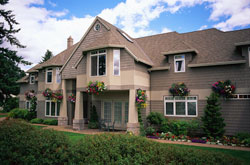Remodeling for Energy Efficiency
See if We Have Top-Rated
Energy-Efficient Remodeling in Your Area

Beneath each visual enhancement you make during a major remodel, there is a chance for efficiency advancement. Energy-efficient remodeling is not only a good idea for helping the environment but also a proven money saver over the long haul. If you're considering a remodel of any sort, it is worth the time it takes to find out if there will be a few chances to increase energy efficiency. Remodeling is definitely a great opportunity to add value and beauty to your home, but if it can also help reduce waste and lower energy bills, your next project will be even more successful!
Energy Efficient Remodeling in the Kitchen
Kitchens remodels are one of the best projects around when it comes to making your home more energy efficient. Kitchen remodels are often focused on surface features such as cabinets, counters, and floors, which can each be made of sustainable materials. The real energy savers in kitchen remodels, however, are the appliances you choose. Government-certified ENERGY STAR products can instantly cut your energy bill by 40 percent since they use less power and water. Plus, they come in any trendy style and size to match your needs. Additionally, if you replace your gas or electric stove with an induction range that uses a small amount of concentrated heat, you'll use less energy while you cook.
Energy Efficient Remodeling in the Bathroom
In bathroom remodeling, energy efficiency is often enhanced best by smaller decisions. As you replace sinks, showerheads and faucets, consider low-flow products that provide water pressure that is just as strong as conventional items while still cutting down on water usage. Low-flow, dual flush and even composting toilets are now easy to find online and in home improvement centers. The addition of any of these fixtures will greatly reduce (and in some cases, all but eliminate!) the water your toilet consumes. One of the best parts of energy efficient remodeling in the bathroom is this: since the mechanisms inside the fixtures do all the work, the exteriors look of the finished room is still up to your personal preference.
Energy Efficient Remodeling Ideas for Other Living Areas
In most cases, bedrooms and living rooms are more difficult to make more energy efficient. Remodeling these areas for efficiency generally focuses on the manufacture and origins of the materials you choose to install. If your new hardwood flooring is sustainably harvested and your new curtains are thick enough to help reduce heat transfer, you're on the right track. Some additions like extra insulation to reduce heat loss and ceiling fans to reduce the need for running the central air conditioning are certainly welcome, but in these areas, energy-efficient remodeling is basically a matter of knowing where your new materials come from and where the materials you remove are bound for. Remember, recycling can be an option for many materials that are pulled from your home, so do your homework before sending all that waste to the landfill!
Energy Efficiency for Landscaping Projects
When it comes to landscaping, do your best to plant vegetation that matches your environment. If you select flowers and shrubs that can easily survive in your neck of the woods, they won't require constant watering or tending. Speaking of water, traditional sprinklers are often unable to control their water distribution, and tend to evaporate the moisture before it has a chance to hit the ground. Instead, buy a drip irrigation system that can concentrate smaller amounts of water onto your plant life, or invest in an underground sprinkler system that can run on a controlled timer. When it's time to plan your outdoor lighting, consider investing in some solar lights. They're not as bright as electric bulbs, but they last all night and cost nothing to use.
Want to make your home energy efficient? Hire a
Home Remodeling Expert
Windows and Insulation for Energy Efficiency
Energy efficient remodeling is rarely going to make as profound a difference as it does when replacing windows and upgrading insulation! Make sure any new windows are double-paned and glazed. Energy-efficient, low-e (low emissive) and spectrally-selective coatings block out UV rays while still allowing light and heat to pass through. Storm windows, solar shades, and window treatments can help to protect your home from solar heat gain. Daylighting, or adding more windows in specific locations, is another great idea. This technique offers a passive way to capture natural sunlight and heat during colder months, thereby saving on electric and heating bills.
Investing in more insulation is a great, energy-efficient, remodeling idea. Though it won't make much of a difference in how your house looks, it can do wonders for reducing heat loss in the winter, maintaining comfortable temperatures in the summer, and reducing energy bills (and energy waste) all year long. While adding or enhancing your insulation is a great idea, it is important to understand that reducing air transfer between indoors and outside can have an effect on your indoor air quality; if adding more insulation, it is generally recommended that you also add ventilation. When installed properly, extra ventilation will keep your indoor air quality top-notch without having an effect on energy bills or the comfort of your living areas!
More Tips & Advice For Your Home
- Related Articles
-
- Recent Articles

